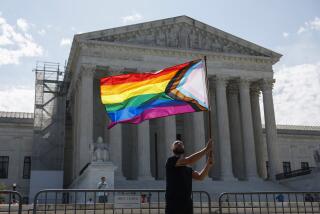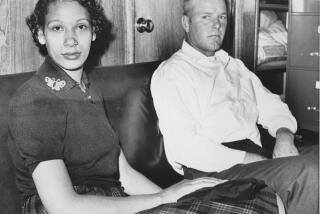Gays growing up and moving on
- Share via
Gay marriage -- what’s not to like? So goes the opening proposition of Jonathan Rauch’s new book. Or as Rauch cheerily puts it, “same-sex marriage is win-win-win. It is good for homosexuals, good for heterosexuals, and good for the institution of marriage.”
If that sounds a bit too much like advertising copy, don’t be put off. In “Gay Marriage: Why It Is Good for Gays, Good for Straights, and Good for America,” Rauch has thought hard about the arguments against gay unions, and he is careful and thoughtful while wrestling with them. Writing for readers on both sides of the issue, Rauch employs a smart and well-timed strategy by appealing to social conservatives on their own terms.
One of the most intriguing things about the push for gay marriage is that it manages to be both deeply traditional and deeply subversive, by embracing and remaking a bedrock social institution. Rauch, who writes that he looked at life “through the weird prism of marriagelessness” for years as a child before understanding that he was homosexual, is a correspondent for the Atlantic Monthly and a writer in residence at the Brookings Institution. He champions marriage in nearly all its codified, old-fashioned trappings (except for the main trapping in question here, that it is between a man and a woman), and he’s happy to part with the socially footloose, sexually free mores of gay liberation.
“Much of what is unique about gay culture -- not all, but much, and particularly at the extremes -- is an artifact of marginalization and infantilization,” Rauch writes. Marriage will benefit gay people by pushing them out of protracted adolescence. “How can a culture fully grow up if it lacks any hope of marriage?” he asks. “For gay culture and gay self-image, marriage is the last and by far the greatest step toward maturity. Within a generation or so, marriage will mean the end of gay culture as we know it.” No misgivings here about donning the straitjacket of the straights.
Yet there’s something disconcerting and a bit sad about Rauch’s stance. Is marriage, with all its strains and constraints, really so superior that gay people should celebrate the demise of the alternative lifestyles that some of them pursue? Rauch acknowledges that many gay couples won’t be rushing to line up at the altar (though San Francisco records show there were nearly 4,000 same-sex weddings in the month before the state courts stopped the ceremonies).
Rauch thinks the central purpose and value of marriage is to ensure that each partner will take care of the other, come what may. He approvingly quotes the 17th century vows in the Book of Common Prayer, with their promise of commitment “in sickness and in health” and “so long as ye both shall live.” He worries that civil unions and domestic partnerships, both of which he calls “marriage-lite” will serve only to undermine the institutional core that he seeks to protect and defend.
Close to a dozen states, the District of Columbia and at least 140 cities and local government agencies already offer some type of domestic-partner benefits. Seventy percent of such programs are available to straight as well as gay couples, according to Rauch. These halfway measures provide shelter from certain legal perils by offering benefits such as inheritance rights. But they fail to impose all the useful burdens of marriage. For example, some domestic partnerships can be dissolved at one partner’s say-so. That’s a bad thing, societally speaking, because the impetus of marital responsibility remains our best bet for domesticating young men and for ensuring that children grow up in two-parent families. “However close a domestic-partnership program may come legally, it is no substitute for the genuine article,” Rauch writes. Marriage “adds value by bringing to bear the weight of social expectations that to marry is to commit.”
Rauch is deft at reducing the theoretical arguments against gay marriage to their less-than-compelling essences. If marriage is really about procreation, he asks, why is it that no one would dream of preventing the infertile or the menopausal from walking down the aisle? Nor need we fear that gay unions will send us hurtling down a slippery slope toward legalized polygamy and incest, when it’s easy to draw this principled distinction: Making gay marriage legal is about allowing each of us to marry someone we love -- but not everyone or anyone.
Then there’s the argument that gay marriage will be bad for kids, because children are best off in a home with a mother and a father. Maybe, maybe not. The empirical evidence about kids raised in gay households is sketchy. But because gay couples are already raising hundreds of thousands of children -- those they give birth to and those they adopt -- it hardly helps to exclude their parents from marriage. “The relevant point is that children will be more secure and happy with married gay couples than with unmarried gay couples,” Rauch observes.
In light of his own penchant for tradition, Rauch finds it trickiest to parry the opposition to gay marriage that simply balks at risky change. “For the entire history of civilization, marriage has been between men and women,” he writes, taking on, for a moment, the voice of a traditionalist. “ ‘I’m sorry .... I don’t know that I can even give you good reasons. It is just that what you are asking for is too much.’ ”
Rauch’s response is as conservative as he can make it. Let the states try gay marriage one at a time, he urges, if and when each state is so inclined. That approach is in sync with the vision the framers wrote into the Constitution. It allows for experiments in states like California and Massachusetts (where the state Supreme Court has ordered up marriage licenses for gay couples beginning in May), while the rest of the country watches. And it ensures that gay marriage won’t be foisted on a community that doesn’t support it. Rauch isn’t worried that other states will have to recognize gay marriage under the Constitution’s “full faith and credit” clause, which requires states to respect each other’s public records and judicial proceedings. He notes the exception to the rule that allows states to reject each other’s marriages on some public policy grounds.
To be sure, negotiating a patchwork of marriage laws will be confusing and unwieldy. But nonuniformity, however messy, seems worth a try if you have any sympathy for Rauch’s view that the current restrictions on marriage are at odds with equality before the law.
Rauch also woos the conservatives with legal history, claiming that marriage has been the “exclusive domain” of the states since colonial times. As feminist legal scholars have pointed out, that reading of history offers more bluster than substance. Over the centuries, federal courts and legislators have involved themselves more or less when it suited them in the laws of marriage, divorce, alimony and child custody. (What’s Loving vs. Virginia, the Supreme Court decision that struck down state laws against interracial marriage, if not federal intervention?) Still, the idea that domestic affairs have been and should be locally controlled has become a conservative mantra. Rauch is right that it’s hardly consistent for conservatives to argue now that a federal constitutional amendment is the best way to settle the gay marriage question.
But the lesson from the past that matters most to conservatives dates from the 1960s and ‘70s, when other states followed Nevada by making divorce easier to get. Rauch thinks that history is unlikely to repeat itself, given the intense attention gay unions have attracted. If same-sex marriage spreads across the country, he says, it won’t be because the states have thoughtlessly waived it through. It will be because they’ve concluded that gay marriage is a good idea.
On this point, Rauch’s book would have benefited from a more thorough discussion of how and why Nevada’s divorce practice became the national norm, so readers could work through the potential parallel for themselves. But the line of inquiry, though not pursued, is a measure of his skill at framing the issues. This is a book that succeeds on its intellectual merits. At the same time, Rauch makes his case perhaps most eloquently in the brief appeal to emotion that he allows himself. “For Michael,” he writes in the book’s dedication, “Marry me, when we can.” As Golde said to her husband, Tevye, in the musical “Fiddler on the Roof,” in a line that Rauch invokes, “If that’s not love, what is?”
More to Read
Sign up for our Book Club newsletter
Get the latest news, events and more from the Los Angeles Times Book Club, and help us get L.A. reading and talking.
You may occasionally receive promotional content from the Los Angeles Times.










